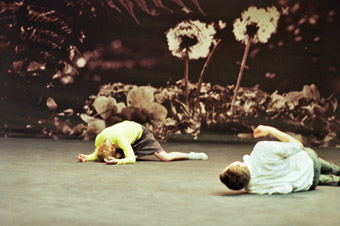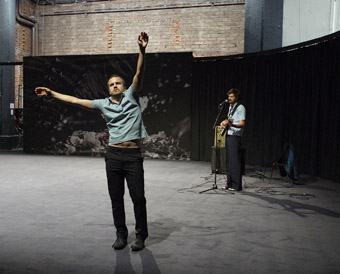 |
Maybe Forever, Meg Stuart, Philipp Gehmacher photo Chris van der Burght |
Choreographed and performed by Meg Stuart and Philipp Gehmacher, the work starts in the dark, with a brooding, evocative soundscape of electronic humming and clicking. After a long while, as low, flickering light grows unnoticed, two indistinct figures are glimpsed, reclining, sleepily shifting, and then touching and pulling at each other. The dark makes reading individual moves and contact more an act of imagination than of sight. As dawn arrives, we are lured inside a crumbling love story.
Suddenly the light is bright, revealing a small structure on the left, half bed half podium, giving the space the feel of a living room-cum-club. Curtains flank a large photographic indtallation at the back, depicting a fern and two dandelions, their luminous fuzz suggesting impermanence.
Meg Stuart launches into a repetitive recital of bittersweet and melancholic thoughts about the affair. “Remember when I said I couldn’t live without you?” she asks. “I take it back.” She takes back statement after statement, once manifestations of affection and passion. Her leather jacket creakes discontently with each of her movements and, gradually, words are overtaken by arm gestures which grow more and more abstract. Throughout Maybe Forever, arm movements and gesture convey much of the communcation between the two.
Philipp Gehmacher has a nerdy manner, awkwardly stumbling through a man-boy haze. He is stiff, speechless until the very end, unable to articulate his emotions. There are moving moments, for example when he stands at the very front edge of the stage, holding his arms high above his head as if waiting to be lifted up, his face bathed in a happy light of distant memories.
 |
Maybe Forever, Philipp Gehmacher, Niko Hafkenscheid photo Eva Wordinger |
There are moments of peace and harmony, Gehmacher sitting upright on the floor, Stuart lying down on her side, her head on his lap. Motionlessly, they listen to the singer playing the beautiful title song, watching the giant dandelions now glowing, lulling their broken hearts.
Soon the pleasure fades, and the tugging, caressing partners slip apart again. All their awkward grappling bears no fruit. In a world falling apart, bodily contact can only provide short moments of solace. Spoken texts and elusive song lyrics evoke sad obsession, futile hope mixed with painful awareness of failure: “Should we say our wishes at the same time so that we don’t hear each other?”
And as the woman tries to take everything back from the romance, and fails to do so, the music plays itself backwards, the melange of noises, voices and fragments of love songs airing an uncomfortable, frustrated longing.
In their character play of disjointed romance, the choreographers allow the work to have the time it needs. It's not only the slow, meditative pacing that's demanding for the audience, but also being witness to the agonizing and desperate disintegration of love and expectation. Maybe Forever, in it’s unhurried stillness, is scattered with broken physical exchanges manifest in gawky duets and solos, punctuated with short-lived moments of intimacy and passion. The complex movements of hands and arms caught in the ambivalence between self-protection and surrender are fascinating. These are bodies that have became foreign to each other.
At the end, the man stands alone on the stage. In loose, unskilled sentences, he acknowledges his loss and the impossibility of holding back the decay of love. He knows it’s over: "I have accepted the place I am in." All three performers are now on stage, festively dressed, she in an orange, sparkling party dress sitting next to the singer with his shiny, deep-blue jacket; the man in black suit and bright yellow shirt, standing at a distance. They have given themselves a new beginning.
10th Indonesian Dance Festival: Damaged Goods & Mumbling Fish, Maybe Forever, choreography & dance Meg Stuart, Philipp Gehmacher, live music: Niko Hafkenscheid, dramaturgy Miriam van Imschoot, lighting Jan Maertens, scenography, costumes Janina Audick, music, sound Vincent Malstaf; Graha Bhakti Budaya, Taman Ismail Marzuki, Jakarta, June 16
Giang Dang is a Hanoi-based journalist, editor and cultural activist.
© Giang Dang; for permission to reproduce apply to [email protected]








 back
back